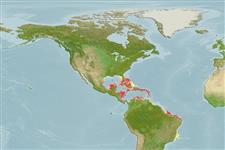>
Eupercaria/misc (Various families in series Eupercaria) >
Labridae (Wrasses) > Xyrichtyinae
Etymology: Xyrichtys: Greek, xyreo = that cuts like a knife + Greek, ichthys = fish (Ref. 45335).
More on author: Castelnau.
Environment: milieu / climate zone / depth range / distribution range
Ökologie
seewasser riff-verbunden; tiefenbereich 3 - 15 m (Ref. 9710). Subtropical; 32°N - 33°S
Western Atlantic: Bermuda and southern Florida (USA) to Brazil; throughout the Caribbean Sea.
Size / Gewicht / Alter
Maturity: Lm ? range ? - ? cm
Max length : 17.5 cm TL Männchen/unbestimmt; (Ref. 9626)
Adults have a vertically elongate blue spot on each scale, the head has alternating vertical lines of pale blue and brownish orange, but these are broader than on X. novacula; adult males are more green in overall color and have a blue-edged inky black spot on midside of body within a pale region of pink or yellow (Ref. 13442).
Most common in shallow, sandy areas in and around seagrass beds. Prefers clear waters (Ref. 9626). Generally of no interest to fisheries because of its small average size (Ref. 5217).
Life cycle and mating behavior
Geschlechtsreife | Fortpflanzung | Ablaichen | Eier | Fecundity | Larven
Robins, C.R. and G.C. Ray, 1986. A field guide to Atlantic coast fishes of North America. Houghton Mifflin Company, Boston, U.S.A. 354 p. (Ref. 7251)
IUCN Rote Liste Status (Ref. 130435)
Bedrohung für Menschen
Harmless
Nutzung durch Menschen
Aquarium: Kommerziell
Mehr Information
NamenSynonymeMetabolismusRäuberÖkotoxikologieFortpflanzungGeschlechtsreifeAblaichenSpawning aggregationFecundityEierEientwicklung
ReferenzenAquakulturAquakultur ProfilZuchtlinienGenetikElectrophoresesVererbbarkeitKrankheitenVerarbeitungNutrientsMass conversion
PartnerBilderStamps, Coins Misc.LauteCiguateraGeschwindigkeitSchwimmstilKiemenoberflächeOtolithsGehirngrößeSehfähigkeit
Tools
Zusatzinformationen
Download XML
Internet Quellen
Estimates based on models
Preferred temperature (Ref.
123201): 26.3 - 28.2, mean 27.5 °C (based on 588 cells).
Phylogenetic diversity index (Ref.
82804): PD
50 = 0.5005 [Uniqueness, from 0.5 = low to 2.0 = high].
Bayesian length-weight: a=0.00813 (0.00406 - 0.01629), b=3.07 (2.89 - 3.25), in cm total length, based on LWR estimates for this species & (Sub)family-body (Ref.
93245).
Trophic level (Ref.
69278): 3.2 ±0.1 se; based on diet studies.
Widerstandsfähigkeit (Ref.
120179): hoch, Verdopplung der Population dauert weniger als 15 Monate. (Preliminary K or Fecundity.).
Fishing Vulnerability (Ref.
59153): Low vulnerability (10 of 100).
Nutrients (Ref.
124155): Calcium = 64.1 [25.3, 133.2] mg/100g; Iron = 0.761 [0.399, 1.731] mg/100g; Protein = 18.5 [15.5, 20.7] %; Omega3 = 0.13 [0.06, 0.26] g/100g; Selenium = 10.6 [4.6, 26.6] μg/100g; VitaminA = 121 [32, 568] μg/100g; Zinc = 1.15 [0.68, 2.10] mg/100g (wet weight);
